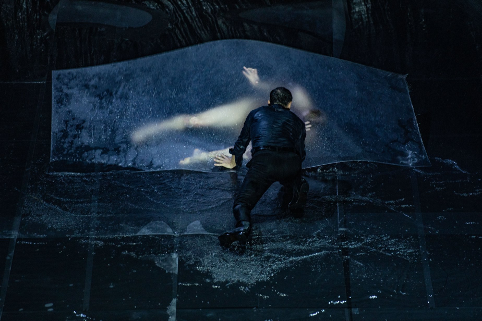Words by Giordana Patumi.
And so, after seven months I am back at the theatre, almost a year after watching the acclaimed The Great Tamer in New York. I am sitting at the Carignano theatre, a metre and a half apart from any other spectator in Turin at the Torinodanza Festival, to watch the world premiere of Dimitris Papaioannou’s INK a duet performed by the choreographer with artist Suka Horn.
There are no works of Dimitris Papaioannou that did not traverse half of the globe. From Still Life to Inside, from Primal Matter to The Great Tamer, Papaioannou’s work has been performed in more than 23 countries. The Greek dancer, choreographer and director – who at the age of 34 directed the opening and closing ceremony of the Athens Olympics in 2001 – is known for creating simple, visionary works which are immersed in a mental, oneiric space that, in addition to splendid visual effects, delve deep into the human condition.
Before lockdown, the choreographer was working on a new production with international artists which was supposed to premiere in May 2020 at Onassis Stegi in Athens, but due to the lockdown the premiere had to be rescheduled. The new premiere date is 16 December 2020 in Athens, which will hopefully go ahead. The lockdown period allowed Dimitris Papaioannou and Suka Horn however, to build a new process, which quickly turned into an encounter/clash between two very different personalities in terms of age and personal stories. Each of them on stage create an almost cannibalistic interdependence in a fantasy world.
Dimitris Papaioannou is today the most powerful creator of a scenic language that interweaves the body with visual art. Man becomes the object of the representation of the artist’s idea, and at the same time the subject of plastic and pictorial forms that draw movements of deep theatrical consciousness and forge a personal contemporary mythology.
In his new work Papaioannou puts water in the spotlight, using an irrigation system to water the fields. In his show it is the scene that is watered: a constant jet wets the choreography and produces the sounds that lead the movement.
“I had thought of creating an installation with some performative interventions. In the end I created a show, which was born from a deep and personal emotional flow, an emotional state very different from my previous works” says the Greek choreographer.
The creation is a site-specific installation entirely imagined and modulated in a dynamic game and repeated recourse; a primary matter that for Papaioannou, almost like for the philosopher Thales, is water. It is a scenic action delimited by nylon walls that entrusts to water and the sound produced by the irrigation systems, the cardinal junction of a peculiar, hermetic, atavistic story.
Papaioannou uses the watery primordial principle to propose and attempt to illustrate multiple paths, here nebulously re-proposed: the unity and harmony of opposites figuratively rendered through dialogue and repeated confrontation with the young collaborator Å uka Horn, the contours of gender identity and the primal relationship between father and son, the perennial flow of becoming, the panic forces of nature and the potential desire for motherhood. “I try to understand life” confesses Papaioannou, “and materialize on stage my feelings and questions about life and then I meet archetypes”.
What we see on stage is a black and grey atmosphere like a horror movie, quotations of Andrej Tarkovskij, angel and demons, the Greek mythology and pieces of plastic. The relationship between the two is dark and complex: who is the young man? Our animal side, the irrational, what we deny about ourselves and do not want to see? Simple elements complete that show. A silver disco ball, a table and a vinyl player from where Vivaldi’s and other music fade into the work while a strange octopus/new-born links every piece of this dramatic jet strong duet connection.
“I try to understand life and to materialise on stage my feelings and my questions. And this is how I meet the archetypes. And when you stumble over the archetypes, you come across the Myth. Because this is what Myths do: they visualize and tell universal themes,” says Papaioannou.
IMAGES: Julian Mommert
